#Pygathrix
Explore tagged Tumblr posts
Text
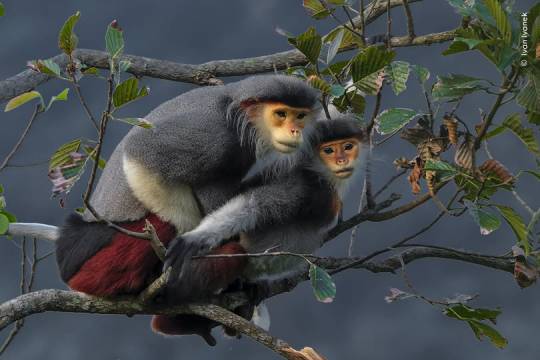
Red-shanked Douc (Pygathrix nemaeus), family Cercopithecidae, Sơn Trà peninsula, Viet Nam
CRITICALLY ENDANGERED.
photograph by Ivan Ivanek
214 notes
·
View notes
Text

Red-shanked Douc
150 notes
·
View notes
Text
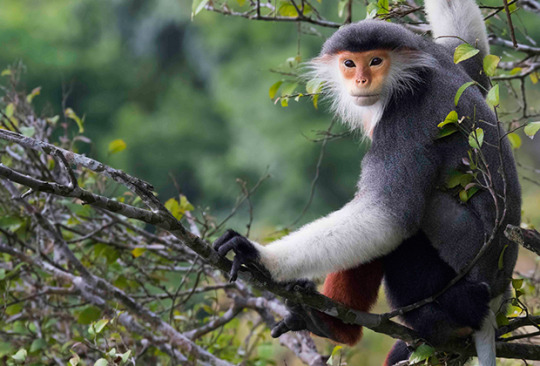
guys im back
enjoy this photo of a douc
source: here
#ape#monke#monkey#primate#ape friends#the monkees#non human#old world monkeys#douc#douc langur#langur#pygathrix
2 notes
·
View notes
Text
Long before we were anywhere near it’s enclosure, we can hear the loud calls of the Siamangs (Symphalangus syndactylus). The largest of the gibbons, the siamang can be twice the size of other gibbons, reaching 1 m (3.3 ft) in height, and weighing up to 14 kg (31 lb).

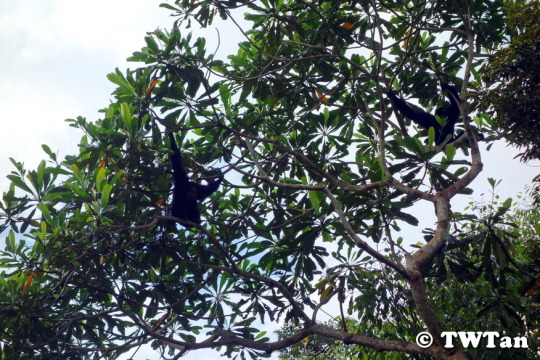

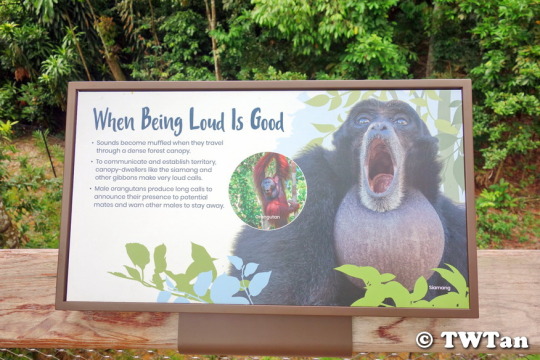
Seeing a small crowd ahead of us, we took a shortcut by walking over the bouncy nettings to the other side. Two male Red-shanked Douc Langurs (Pygathrix nemaeus) were sitting on the railing posing for the cameras and handphones. They looked like old men in grey suit, brown pants and white sleeve.




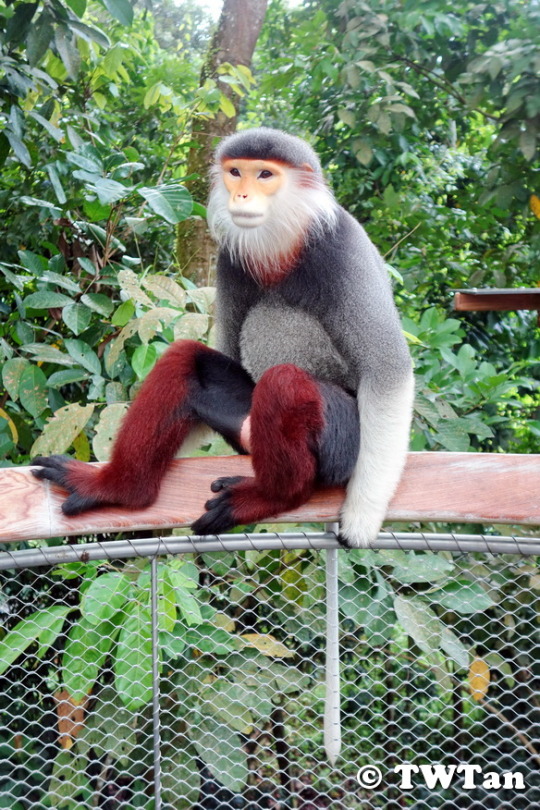
#Rainforest Wild Asia#Mandai Wildlife Reserve#Newly Open#Zoological Park#Siamang#Gibbon#Symphalangus syndactylus#Red-shanked Douc Langur#Pygathrix nemaeus#Primate#Wild Animals#Flora#Fauna#Company's Outing#Buffetlicious
106 notes
·
View notes
Text
A Taste Of Life
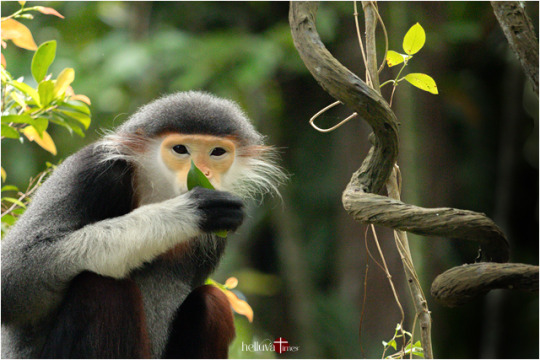
A Douc Langur enjoying its snacks in the local zoo. Photo credit: Jonathan Chua.
#photographers on tumblr#canon 55-250mm#canon eos rp#canon photography#flora fauna#monkey pics#Pygathrix nemaeus#red-shanked douc langur photos#wildlife photography
3 notes
·
View notes
Text
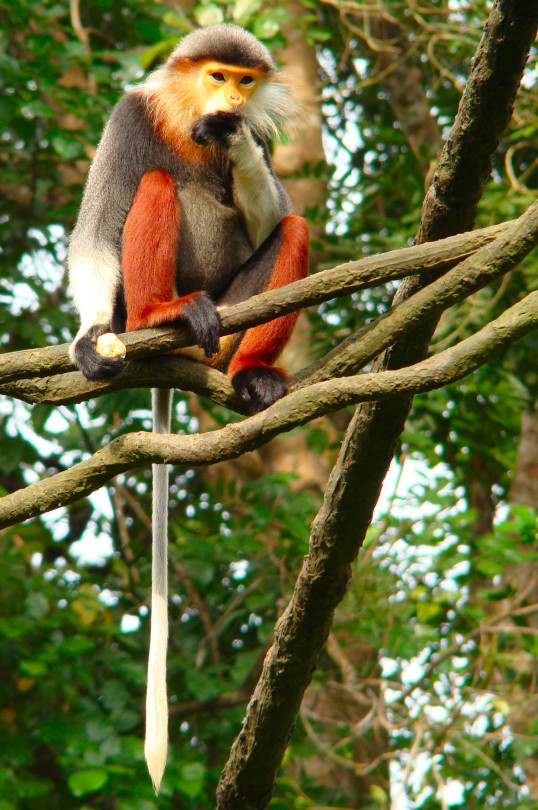
Looking for fashion inspiration? Check out the red-shanked douc (Pygathrix nemaeus). The markings on this primate’s legs resemble bright red trousers. This colorful monkey can be spotted in the forests of Cambodia and Vietnam. It’s a picky eater that closely inspects food, such as fruit and leaves, before consumption. What does it look for in a meal? Unripe fruit is preferred, along with younger leaves, which are easier to digest than older ones.
Photo: Bjørn Christian Tørrissen, CC BY-SA 3.0, Wikimedia Commons
506 notes
·
View notes
Text
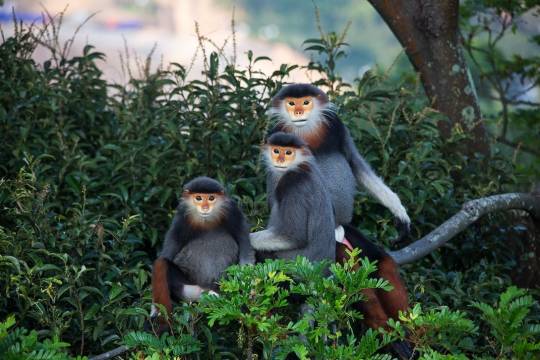
Red-shanked Douc (Pygathrix nemaeus)
Habitat & Distribution
They reside mainly in tropical rainforests
Native to southeast Asia, specifically Vietnam, Laos, and Cambodia
Physical Description
Weight: Between 8.6–11.4 kilograms (19–25 lb) for males, and 6.6–10.5 kilograms (15–23 lb) for females
Height: 55–82 centimetres (22–32 in); females tend to be slightly shorter
The base color of the red-shanked douc is silver, covering both the head and body; the shoulders are black, and the chest and limbs are russet brown
The face is golden, and framed by a whispy white mane
Like most monkeys, the red-shanked douc has a long tail which is used mainly for balance
Behaviour
Spends most of its time in the canopy foraging for buds, young leaves, and fruit
Red-shanked doucs live in groups of up to 50 individuals, with hierarchies for both males and females
The main predator is humans, although birds of prey and large felids
Key Advantages
Red-shanked doucs are fast and agile climbers
Despite their coloration, they are adept at hiding among the dense foliage of the canopy
Photo by Trang Nguyen
46 notes
·
View notes
Text
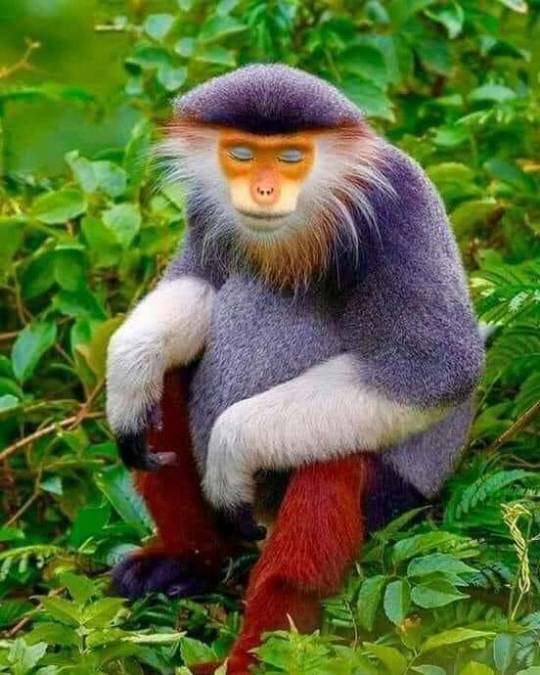
The beautiful red-shanked duoc (Pygathrix nemaeus) is one of the most colorful species of monkey in the world, and is found in Vietnam, Cambodia and Laos.
Photo: Mogens Troll
110 notes
·
View notes
Text
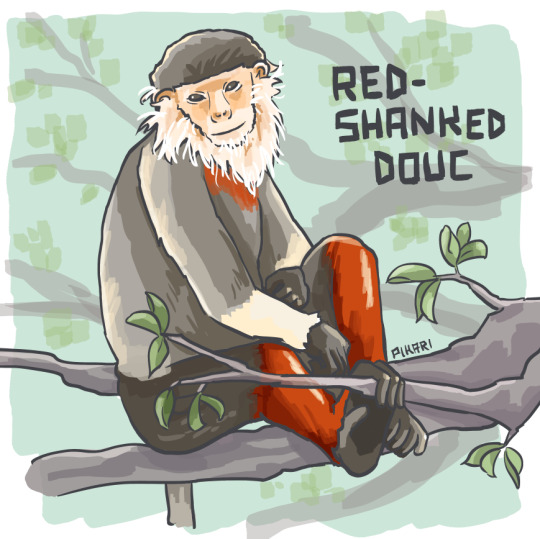
The past is already gone. The future is not yet here. Look deeply at life in the here and now. —Gautama Buddha
Red-Shanked Douc (Pygathrix nemaeus)
Laos, Vietnam, Cambodia
Status: Critically Endangered
Threats: illegal trade and hunting, habitat fragmentation
-----
Here's your monkey!! Thanks for getting me past 100 followers, and welcome to all new followers! 💚
I found these doucs the other day while looking at other species in Vietnam. These are officially my favorite monkey now!!* I am in love with their angelic faces. I feel like they must all be ascended buddhas with their childlike but ageless faces (even their behavior is peaceful compared to other species), so I looked for a buddha quote as the caption today.
I realized I want my blog to reflect this spirit. When thinking about endangered species, it can be too easy to despair about both the future and the past. But I just want to show the beauty** of what we have today.
(*I don't believe I had a favorite monkey before, but I do now.)
(**And that includes the weirdos!)
#which doesn't mean not to act today#but that we shouldn't project ourselves into anything but the present#as much as is possible#hopepunk#monkey#monkey art#primate#vietnam#laos#cambodia#asia#southeast asia
33 notes
·
View notes
Text
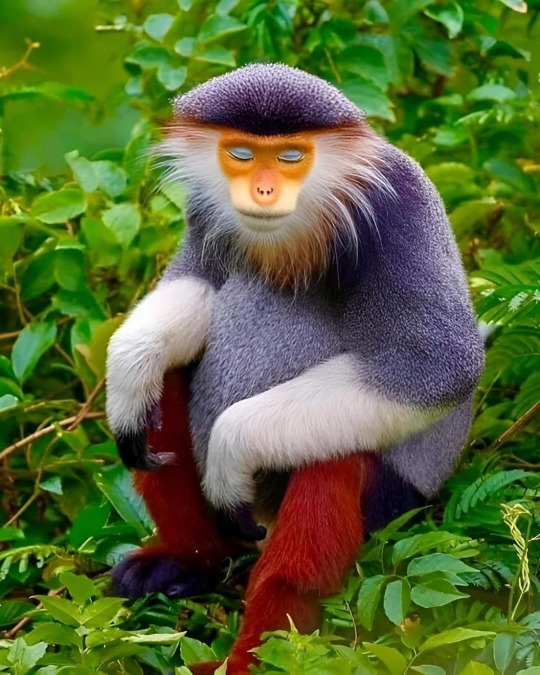
Red-shanked douc (Pygathrix nemaeus)
This fabulous-looking species is found in tropical, sometimes mountainous forests of Southeast Asia. They eat mostly leaves, and have a multi-chambered stomach which allows them to ferment their food, like a ruminant!
#markhors-menagerie#primates#old world monkeys#monkeys#animal facts#fun facts#animals#biology#red shanked douc
75 notes
·
View notes
Text
The critically endangered black-shanked douc (Pygathrix nigripes). A very funny-looking animal, if you ask me. This was at Sriayuthaya Lion Park in Thailand this summer. They have since disappeared from the collection or moved backstage.
2 notes
·
View notes
Note
Hey, do you have any monkies? I'm collecting a lost for a very knowledgeable 6yo to research, so if you have any cool looking ones, he'd love them! Thanks :)
I might have a few cool monkeys for you!

Black-footed Gray Langur (Semnopithecus hypoleucos), family Cercopithecidae, southern India
photograph by @shaazjung

White-headed Marmoset (Callithrix geoffroyi), family Callitrichidae, eastern Brazil
Photograph by Luis Palacios

Mandrill (Mandrillus sphinx), male, family Cercopithecidae, Gabon
photograph by @mogenstrolle

Lion-tailed Macaque (Macaca silenus), family Cercopithecidae, endemic to the Western Ghats of India
photograph by Sandeep Dutta

Red-shanked Douc (Pygathrix nemaeus), family Cercopithecidae, found in Laos, Viet Nam, and Cambodia
ENDANGERED.
photograph by Miriam Blas Nombela

Golden Monkey (Cercopithecus mitis kandti), family Cercopithecidae, Rwanda
Subspecies of the Blue Monkey.
photograph by m107791


White-faced Saki (Pithecia pithecia), males, family Pitheciidae, found in the central area of northern South America
photographs: Jindřich Pavelka & Skyscraper


White-headed Langur (Trachypithecus leucocephalus), family Cercopithecidae, endemic to Guangxi, China
CRITICALLY ENDANGERED.
Photograph by VCG via: China Plus Culture
146 notes
·
View notes
Text
Red-shanked douc (Pygathrix nemaeus)
u couldnt even fathom my compassion
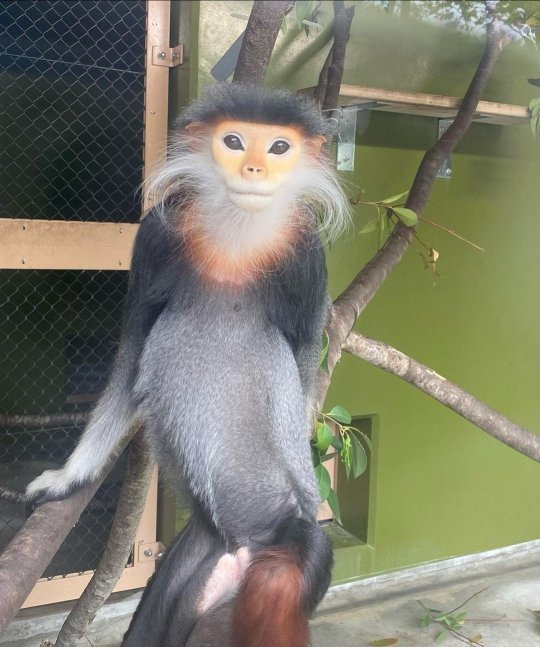
4K notes
·
View notes
Photo
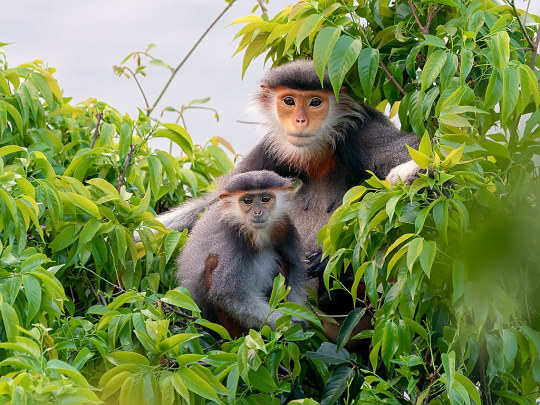
Red-shanked douc (Pygathrix nemaeus)
Photo by David Cook
#red shanked douc#douc langur#pygathrix nemaeus#pygathrix#colobinae#cercopithecidae#catarrhini#simiiformes#haplorrhini#primates#primatomorpha#euarchontoglires#boreoeutheria#eutheria#mammalia#tetrapoda#vertebrata#chordata
78 notes
·
View notes
Text
Support yourself
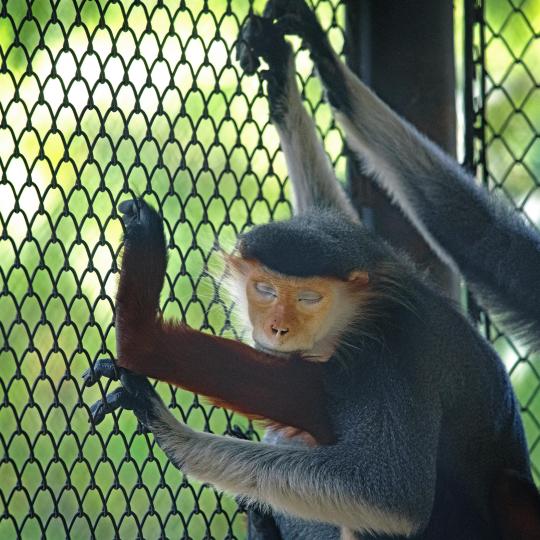
Sleepy douc using red-shank headrest for a nap
The doucs are a family of monkeys often associated with langurs, and is referred to as costume monkeys. They are the most colourful monkeys there are, this one with red shanks, blue and grey fur, yellow-red face and blueish "eye-makeup".
Critical conditions
The doucs are all native to Indochine, the red shanks doucs are native to PR Laos, Viet Nam and northern Cambodia. They are critically endangered, hunted for medicin, food and glue-production. And, being tree-dwellers, human building projects involving removing forest and jungle.
During the hottest hours of the day they seek together and sleeps until the temperature is cooler for having fun, the food and party.
I can totally relate to that.
Learn more in Red-shanked douc (Pygathrix nemaeus).
#bangkokzoo#lostforever#2018#redshanked#douc#Pygathrix#nemaeus#monkey#naptime#red#monkeylegs#chaos#2018CE#bangkok#thailand#lastchancetosee#dusit#zoo#dusitzoo#animalphotography#citylife#citywalk#art#bluesky#buddhism
1 note
·
View note
Photo
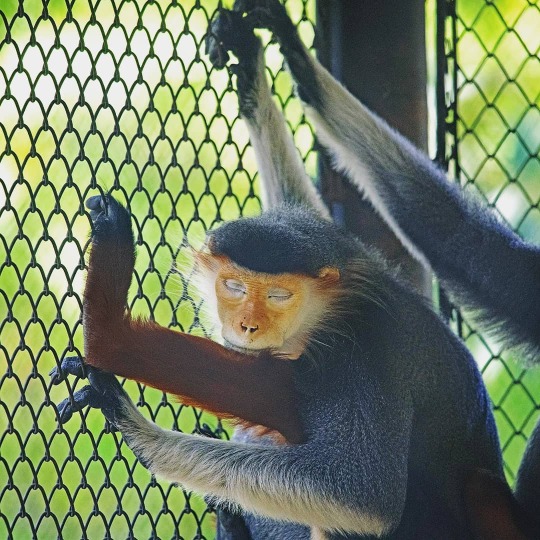
Sleepy douc using red-shank headrest for a nap The doucs are a family of monkeys often associated with langurs, and is referred to as costume monkeys. They are the most colorful monkeys there are, this one with red shanks, blue and grey fur, yellow-red face and blueish "eye-makeup". The doucs are all native to indochine, the red shanks doucs are native to PR Laos, Viet Nam and northern Cambodia. They are critically endangered, hunted for medicin, food and glue-production. And, being tree-dwellers, human building projects involving removing forrest and jungle. During the hottest hours of the day they seek together and sleeps until the temperature is cooler for fun, food and party. I can totally relate to that. Red-shanked douc (Pygathrix nemaeus) https://en.m.wikipedia.org/wiki/Red-shanked_douc #bangkokzoo #lostforever #2018 #redshanked #douc #Pygathrix #nemaeus #monkey #naptime #red #monkeylegs #chaos #grooming #selfconfidence #2018CE #bangkok #thailand #lastchancetosee #dusit #zoo #dusitzoo #animalphotography #birdphotography (ved Dusit Zoo, Bangkok, Thailand) https://www.instagram.com/p/CHnkVkkJUCK/?igshid=wkwav2d4f36j
#bangkokzoo#lostforever#2018#redshanked#douc#pygathrix#nemaeus#monkey#naptime#red#monkeylegs#chaos#grooming selfconfidence 2018CE bangkok thailand lastchancetosee dusit zoo dusitzoo animalphotography birdphotography
0 notes